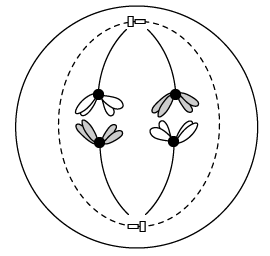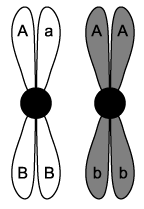a)
The diagram below summarises the processes of mitosis and meiosis.
Identify the process marked X in the diagram.
[1 mark]
Assess your score
View Answer
b)
Identify the stage of the cell cycle during which the process marked X in part a) takes place.
[1 mark]
Assess your score
View Answer
c)
Describe one way in which the process marked X in part a) can increase genetic variation.
[2 marks]
Assess your score
View Answer
d)
Describe the chromosome activity taking place at the stage marked Y in the diagram in part a).
[2 marks]
Assess your score
View Answer
Next Question
a)
The diagram below shows two chromosomes during meiosis.
Identify structures X -Z .
[3 marks]
Assess your score
View Answer
b)
Outline the events shown in the diagram in part a).
[3 marks]
Assess your score
View Answer
c)
At the end of meiosis the chromosomes shown in part a) form four new chromosomes, as illustrated in the diagram below.
Annotate the four new chromosomes below to show the results of the events shown in part a). The first chromosome has been annotated for you.
[3 marks]
Assess your score
View Answer
d)
Outline the importance of the process shown in part a) to living organisms.
[2 marks]
Assess your score
View Answer
Previous Question Next Question
a)
The diagram below shows a cell in anaphase of meiosis I.
State how it is possible to know the following:
i)
That the cell is in anaphase.
[1 mark]
ii)
That the cell is in meiosis I.
[1 mark]
Assess your score
View Answer
b)
Meiosis I is described as reduction division.
State why this is the case.
[1 mark]
Assess your score
View Answer
c)
Meiosis I generates genetic variation due to the process of crossing over.
Outline one other process during meiosis I that generates genetic variation.
[2 marks]
Assess your score
View Answer
d)
Rice, Oryza sativa , has a chromosome number of 24.
Use the formula 2n n here denotes the number of pairs of chromosomes.
[2 marks]
Assess your score
View Answer
Previous Question Next Question
a)
The diagram below shows chromosomes from a garden pea plant, Pisum sativum , during meiosis.
Identify, with a reason, the meiotic division that is occurring in the diagram.
[2 marks]
Assess your score
View Answer
b)
Mendel's law of independent assortment states that:
'Characteristics are inherited completely independently of each other'
While the chromosomes in part a) will undergo independent assortment during meiosis, this law of Mendel's cannot be correctly applied to the characteristics for which genes A and B code.
Explain why this is the case.
[1 mark]
Assess your score
View Answer
c)
At the end of meiosis the chromosomes were distributed to the pea plant pollen grains as shown below.
Explain how the chromosomes in part a) gave rise to the new allele combinations shown above.
[2 marks]
Assess your score
View Answer
d)
The process in part c) and independent assortment both contribute to genetic variation.
State one other process that contributes to genetic variation.
[1 mark]
Assess your score
View Answer
Previous Question Next Question
b)
Outline the events that take place during the second division of meiosis.
[5 marks]
Assess your score
View Answer
Previous Question





